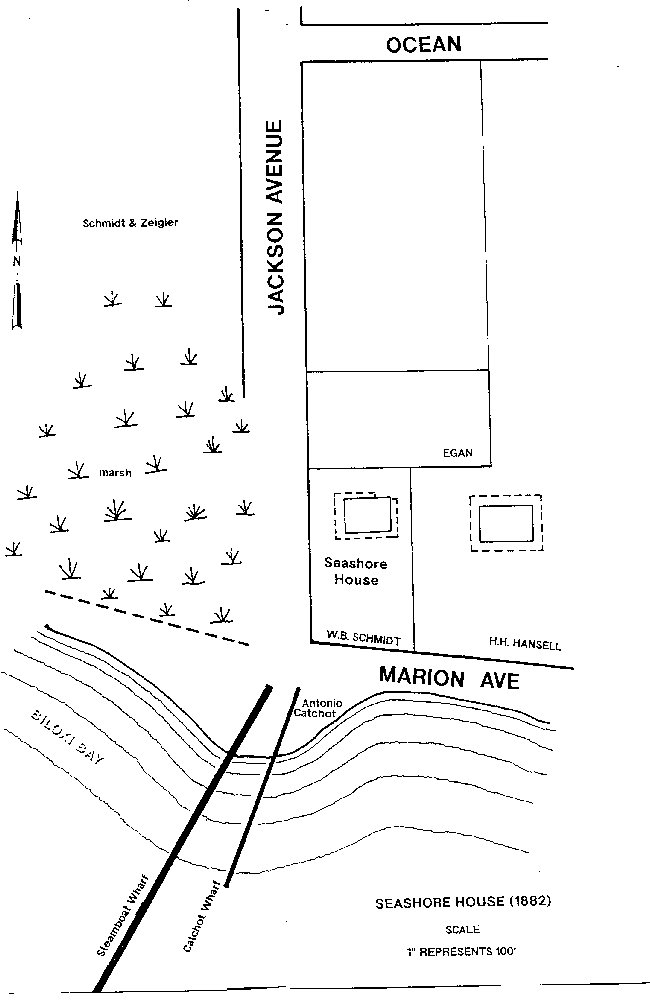Seashore House (1855? - 1886)
Seashore House (1855? - 1886) ray Tue, 04/20/2010 - 21:46- 123 views
LOCATION
The Seashore House was located on the east side of Jackson Avenue and Front Beach Drive (called Marion Avenue at that time). The lot was 113 feet on Marion and 192 feet on Jackson.

BUILDING
No description or photograph of this structure is known to the author at the present time.
HISTORY
Currently other than brief statements in books not much has been discovered about the Seashore House in the literature. In 1933, Schuyler Poitevent (1875-1936), a scholarly gentleman, who lived most his life at his Lovers Lane home on Biloxi Bay and wrote short stories and novels none of which were ever published, interviewed octogenarian, Josephine Bowen Kettler (1845-1933+). Mrs. Kettler was the daughter of the Reverend Philip P. Bowen (1799-1871), a Baptist minister, who was an early pioneer at Ocean Springs. From his conversation with Kettler, Mr. Poitevent wrote a romantic picture of early life at Ocean Springs. The following is taken from Broken Pot, an unpublished novel, written by Poitevent:
As she (Mrs. Kettler) talked, I felt myself going back to the time she was telling me about, and I could see in imagination her ante-bellum Ocean Springs with its straight, tall pine-trees which the charcoal hand of men in time felled and with its grey-trunked live-oaks and with its white, sandy roads winding in and about gallberry thickets and through patches of graceful latanier and heading branches where sweet-bays and magnolias and chinquepins and wild honeysuckle---"azalias", the young ones now call them ---was so much a part of our fair Land then as now that we unconsciously accept their charm now as then as a part of a land as the Land should be; and I imagine I heard Captain Walker blowing the loud whistle of the good steamboat "Creole" of the old Morgan Line, on her regular passenger packet run of every other day from New Orleans to Ocean Springs and return, pretty much like the "Coast Train" of our times, only not so often; and I could see the proud people of her day, with grinning kinky-headed slaves for coachmen, driving in old-fashioned, heavy carriages down to the foot of the old steamboat wharf---driving through that white sandy road which nowadays opens to view the beautiful vista beneath the arched live-oak limbs that overhang our paved Jackson Avenue; and from the foot of the wharf, I could in imagination hear the paddle-wheels of the steamboat striking the water and out on the long wharf of one thousand and seventy-five feet I, too, went along with the others to see the boat come in; and as I stood on the pier, I saw out in the Bay mullet jumping and saw the sharks striking and saw the many pelicans feeding and some were sailing in long streams; and then the boat approached and I saw a deck-hand heave the lead-line and I saw nigger slaves on the pier-head catch it and haul the hawser in, and I saw the mate lower the stage-plank and I saw the passengers, in the queer costumes of those old summer days---the ladies in big-hooped skirts, tight waists and flat hats; the gentlemen in tight pantaloons, shirts with ruffled fronts and crossed cravats and broad-brimmed beavers---disembark; and back up the long wharf in the bright forenoon sunshine, I followed the passengers and the people ashore, and most all stopped at the Old Seashore Hotel on the west side of the road at the foot of the wharf where now stands the Sacred Heart Convent, and there attached to the hotel, they had a store, and in the store was the post-office; and in imagination, I heard people step up and ask: "Any mail for me Mr. Eagen?"
The Seashore House lot was originally a part of Lot Number Two of the Widow LaFontaine Claim (Section 37, T7S-R8W). It was in the possession of Robert B. Kendall in September 1846. Kendall conveyed his interest to E.R. and Henrietta S. Porter before 1855 for in October of that year, the Porters sold the Seashore House tract (113 feet x 192 feet) to J.E. McGehee of Helena, Arkansas and Mary J. Jourdan of New Orleans for $900. McGehee conveyed his half interest to Jourdan in December 1859.(JXCO, Ms. Land Deed Bk. 4, pp. 243-245)
After Mrs. Jourdan died sometimes before 1881, her daughters and sole heirs, Kate Peniston Maurice Jourdan and Augusta Sophia McGehee Jourdan of New Orleans, inherited the property. They sold the house and lot to W.B. Schmidt of New Orleans on August 8, 1881. Schmidt was a partner in the well established Ocean Springs Hotel (1853-1905) up the block on the west side of Jackson Avenue.(JXCO, Ms. Land Deed Bk. 5, pp. 228-229)
It appears that W.B. Schmidt didn't want any competition for his Ocean Springs Hotel because when he sold it to Captain Raphael "Ralph" Beltram (1828-1898) in November 1886, it was stipulated in the conveyance deed that Beltram "at any time or times here after, establish, open or keep, or allow to be established, opened, or kept on the premises hereby granted and conveyed any coffee house, saloon, bar room, or public establishment, for the sale of wines, or liquors without the consent of the said W.B. Schmidt, his heirs, or assigns". Beltram named his residence "San Souci". The site was acquired by the Marianite Sisters of the Holy Cross in 1899.(JXCO, Ms. Land Deed 8, pp. 292-293 and Bk. 20, pp. 104-106)
Raymond J. Hudachek purchased the property from the Reverend Joseph B. Brunini, Bishop of the Catholic Diocese of Natchez-Jackson, as Trustee of the St. Alphonsus Parish, in March 1976.(JXCO, Ms. Land Deed Bk. 559, p. 678)
REFERENCES:
Schuyler Poitevent, Broken Pot, "Biloxi Bay" (Chapter 7), (Mississippi State Department of Archives and History: Jackson, Mississippi-1933-unpublished), p. 5.